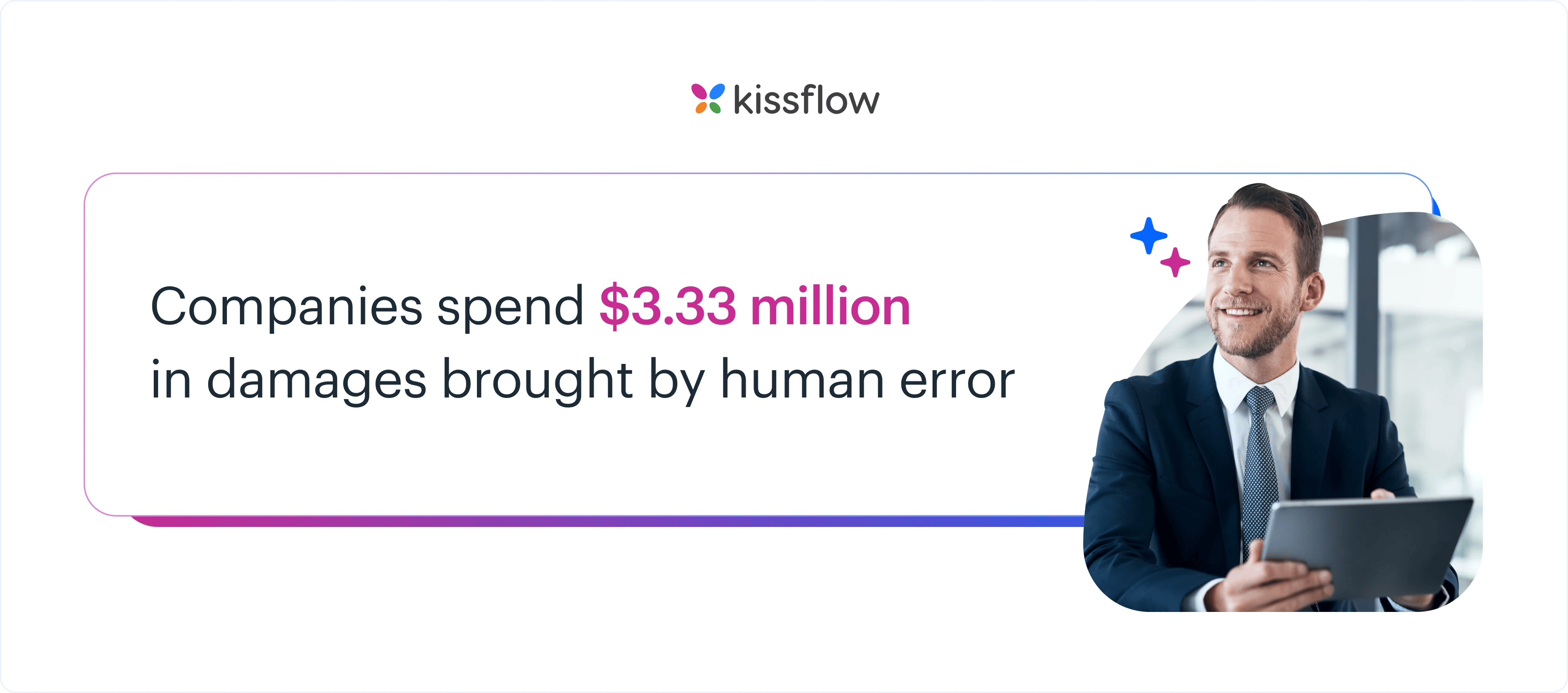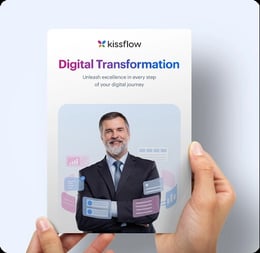
- >
- Digital Transformation >
- Digital Transformation Case Studies to Inspire Every Business
Digital Transformation Case Studies to Inspire Every Business
Why Internal Operations Are the Fastest Path to Digital ROI
Many digital transformation efforts stall because they focus only on customer-facing systems. But internal operations—HR, finance, procurement, and others—often remain fragmented and manual. The result: stalled approvals, disjointed workflows, and frustrated employees. A well-documented digital transformation case study shows that streamlining internal operations with automation and no-code platforms can be just as critical as upgrading customer-facing tools.
The biggest challenges of internal operations
Challenge 1: Poor communication
Messages and important announcements get lost in long email threads, withholding the progress of employee and/or customer requests.
Challenge 2: Human error

Challenge 3: Skill gap
Poor training and lack of access to digital solutions hinder the employees’ productivity during a digital transformation initiative.
Challenge 4: Siloes
Specialized assignments minimize opportunities for collaboration and communication across departments.
Empowering businesses with digital work platform
Productivity
Kissflow has aided many businesses to optimize how they plan and keep track of projects and events, and maintain communication for better performance—serving as a strong digital transformation case study for enterprises looking to modernize internal operations.
1. Olympus
Workflows and systems are also susceptible to stagnation. Olympus needed a modern, intuitive, and automated platform to enhance processes and hasten the delivery of tasks.
2. Vietnamobile
Efficiency was a top priority for the Hanoi-based Vietnamobile. It envisioned adopting a digital workplace management platform for easy tracking and reliable internal communication.
3. Quality Companies LLC
Logistics company Quality Companies gathered countless documents via email daily. It needed a clear documentation trail to stay on top of requests and processing dates.
4. Davenport University
Universities are no strangers to budget cuts and complex procedures to manage requests. Davenport University sought an innovative solution to save time on processing student forms and other documents.
Approval
Leading businesses have leveraged Kissflow to streamline the handling and management of approval requests to avoid delays in their workflows, making them notable examples of digital transformation case studies.
5. GreenCube Global
Speed and precision are vital to handling finance documents. GreenCube Global required a payment approval solution to monitor requests exchanged between managers and the finance department.
6. Bergstrom
Control is necessary for volatile scenarios such as managing write-off processes. Wisconsin’s biggest automotive dealer Bergstrom sought a more streamlined workflow in its accounting department.
6. Verisys
Data management in the healthcare industry is a big responsibility for Verisys. Moderators and aggregators needed well-coordinated workflows for swift approval processes.
7. Tripwolf
Startups need compelling systems to succeed among big players in the market. Tripwolf, a startup travel agency, sought to automate employee leave requests for easy approval and adjustment of workload.

Get your free digital transformation brochure
Thank you for reaching us!
Automation
Kissflow has helped many organizations reimagine manual processes with automation for better execution of business operations and communication in the workplace.
8. Landmark Properties
Automated workflows nurture transparency and collaboration. Real estate firm Landmark Properties empowered its marketing and other teams, with a central workplace platform to enhance efficiency.
9. Project SYNCERE
Manually going through documents from over 20 programs overwhelmed the staff of Project SYNCERE. The non-profit organization embraced the power of automation and improved internal operations.
10.Beqom
For developers such as Beqom, requests go through multiple pipelines across the world to receive approval. Automated workflows helped them simplify processes and keep track of pending requests.
11. Lincoln Financial Media
The media industry is heavily engaging in digital efforts to maximize its campaigns. Lincoln Financial Media left traditional paper forms and archives for a fully digital and collaborative platform. Embrace digital transformation with Kissflow
All-in-one digital transformation solution
From workflow management and process automation to application development, Kissflow offers comprehensive tools to bolster your digital journey on a single interface, as highlighted in various digital transformation case studies.
Empower and engage business users
Business users bring solutions to life with locally-made business-critical applications, boosting confidence and satisfaction at work.
Real-time reporting and performance analytics
Keep track of performance, documentation, and audit trails with clear and concise reports. Get insights from multiple apps to build powerful and accurate reports
Scale revenue growth
Digital transformation platform like Kissflow cut back operational costs by 10% and boost revenue growth to up to 15%[1].
Customer testimonials
Don’t just take our word for it—hear the success stories directly from our customers.
Olympus
“With Kissflow, I got used to developing processes very fast and the support given was very helpful.”
- Griselda Juve, Purchaser
Tripwolf
“Kissflow has the most important workflow features. It does exactly what it should.”
- Wilfried Schaffner, CEO
Lincoln Financial Media
“Kissflow does exactly what we hoped it would. We are very happy with the product and support is quick to respond.”
- Matt & Remy, Lincoln Financial
Wayne Metropolitan
“We were able to completely customize and change forms at any point without needing to contact an IT desk or have a background in programming.”
- Yvonne Herman, Chief Human Resource Officer
McDermott
“This is so easy, even my mom could do this.' It was extremely intuitive and straightforward. The watermark was, 'I don't need to call IT to do this. I can do it myself. “
- Renee Villarreal, Senior IT Manager
Arvada Fire
“PO approvals are so much easier. We've gone from two days to a few hours. It's fantastic!”
– Chris, Arvada Fire
FAQ's- Digital Transformation Case Studies
1. What is an example of a digital transformation case study?
Olympus is a strong example of digital transformation. The company adopted Kissflow to modernize outdated workflows and speed up task delivery. By switching to a no-code work platform, Olympus eliminated manual delays, improved communication, and reduced reliance on IT for routine process changes.
2. What are the 4 types of digital transformation?
The four types of digital transformation are process, business model, domain, and cultural transformation. Process transformation focuses on improving internal operations with automation. Business model transformation changes how a company delivers value, often through new revenue channels. Domain transformation involves entering new markets using digital capabilities, while cultural transformation aligns people, skills, and workflows with a digital-first mindset.
3. Why does digital transformation matter?
Digital transformation improves how organizations operate, make decisions, and respond to change. It helps them replace outdated, manual processes with digital workflows that are faster, more accurate, and easier to scale. It also builds long-term adaptability by giving business teams the tools they need to solve problems independently—without waiting on IT.
4. Which industries are undergoing digital transformation?
Nearly every industry is evolving, but sectors like finance, manufacturing, healthcare, retail, and logistics lead the way. These industries face high volumes of manual tasks, complex workflows, and rising customer expectations—making them ideal candidates for automation, low-code application development, and connected systems.
5. What do digital transformation processes look like?
A digital transformation process usually begins with identifying operational gaps and high-friction workflows. Next comes selecting the right platform, setting up governance, and rolling out no-code or low-code solutions across departments. It’s not a single project—it’s a continuous shift in how teams work, collaborate, and solve problems with technology.
6. What are the benefits of digital transformation?
Organizations that embrace digital transformation see measurable gains—faster turnaround times, better data access, fewer manual errors, and reduced operating costs. It also improves employee satisfaction by enabling teams to work with tools they can manage and adapt themselves. For CIOs, it clears IT backlogs and frees up resources for more strategic work.
Join the community of leaders in digital transformation

The No-Code Approach to Unlock Citizen Development Excellence
Thanks for the download
Related Articles











